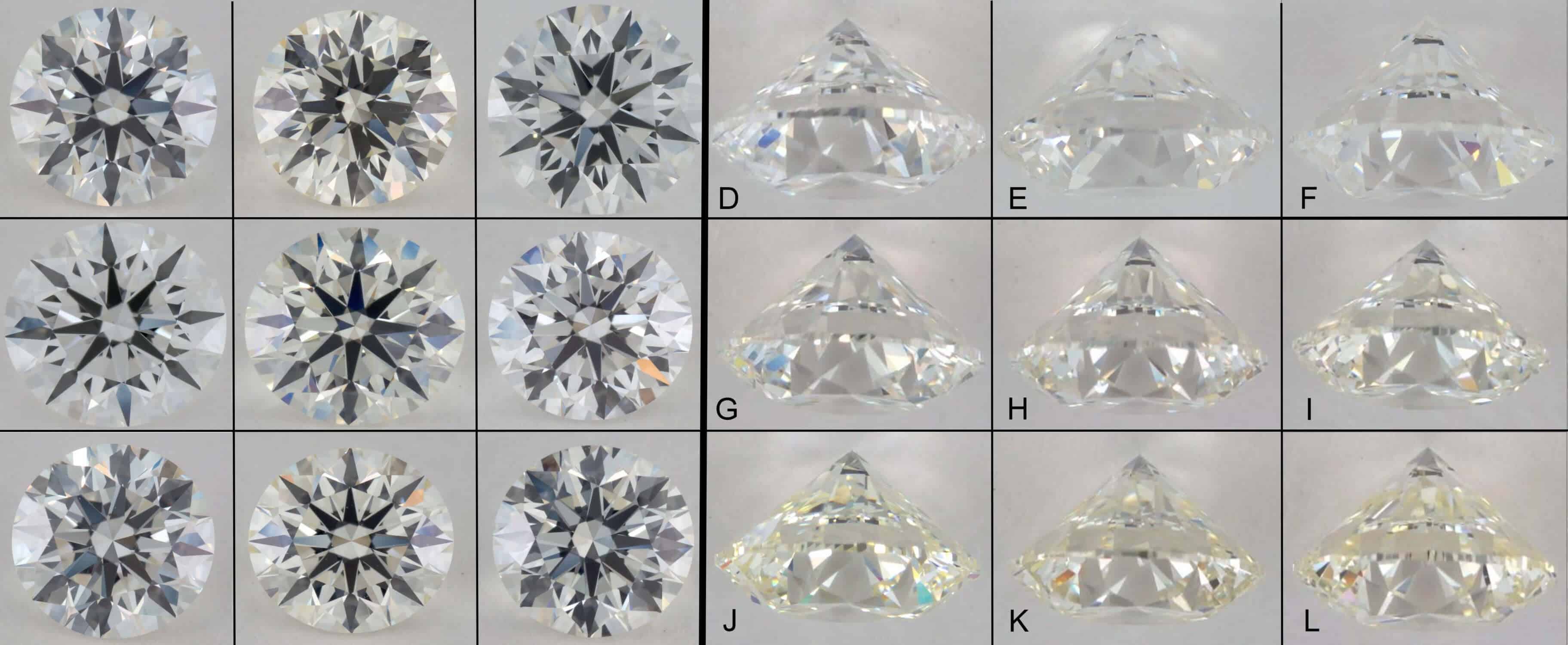While lab-grown diamonds are made by man, there are still imperfections similar to those in natural diamonds. Lab-grown diamonds are graded on the color scale, which starts with D (completely white) and goes to Z (yellowish tint). Not only do these color grades impact the visual appearance, but they also impact the price of the diamond. In this article, we will cover everything you need to know to utilize a lab-grown diamond’s color grades to get a fantastic diamond at a great value.
Here is what we’ll cover in this article:
What is diamond color?
Diamond color chart
How to pick the right diamond color?
The diamond color scale for white diamonds
Bottom line recommendation
Why you should trust us
Diamond Color: An Introduction
In general, diamonds with a slight yellow or brown tint aren’t as desirable. With a distinct tone like a yellow tint, less natural color can reflect back to the eye. The more colorless a diamond is, the more radiant and valuable it is as well. That’s why color is a trait that you won’t want to overlook. It’s important to find a stone that looks white without overpaying.
While it might seem like man-made diamonds should be perfectly white, lab-created stones aren’t created flawlessly. There are still distinctions in the quality, color, and other traits of each stone.
A lower color grade typically results in a lower price. For example, this 1.38 carat F color diamond from James Allen costs $230 more than this 1.36 carat I color diamond. Depending on the setting, whether it’s white gold or yellow, both diamonds may appear colorless. That’s why it’s important to understand diamond color and how it’s impacted by your ring’s design.
Fancy color diamonds: If you’re in the market for a fancy color diamond, like a pink or blue diamond, focus on the richness of the color.
What To Know About Diamond Color
- The absence of color impacts the value and price of the diamond
- Color grade should always be determined by a grading professional
- Fancy colored diamonds are graded differently than colorless stones
- The ring’s setting plays a role in the perception of the color
Understanding the color quality helps you know exactly how lab-created diamonds are priced so that you can get the best value.
Lab-Created Diamond Color Scale Chart
As you compare diamonds, it’s important to have verification for what you’re looking that. That’s why we recommend having an IGI (International Gemological Institute) certificate for every lab-created diamond you consider. This differs from our advice on natural diamonds (you should always seek a GIA certificate on those). Why IGI for lab-created stones? Because the IGI issues specific grades for lab-created stones and most of the lab market uses them, whereas the GIA has only just started and there isn’t many of them out there.
The IGI grades diamonds on the following diamond color scale of D to Z, with Z being a diamond with a noticeable yellow or brown color.
| Colorless | As the highest color grade, D means the diamond has almost no color even under magnification. E and F ratings look identical to the naked eye. Only an expert gemologist is able to note the differences between D, E, and F grades. | |
| Nearly Colorless | | G-J color graded diamonds have nearly no color and appear mostly colorless to the naked eye. In most cases, they will look the same as D to F diamonds but are priced much lower. |
| Faint Tint | | Diamonds in K-M range show a slight yellow tint when viewed with the naked eye. Some people prefer these warmer diamonds set in a beautiful yellow gold setting like this one from James Allen. |
| Very Light Tint | The noticeable yellow or brown tint of N-R diamonds make them available at much lower prices. We generally don’t recommend diamonds in this color range. If you’re looking for a colorful stone, we suggest searching for a beautiful fancy color diamond like a yellow, pink or blue diamond. | |
| Light Tint | Diamonds in the S-Z range have a distinct yellow or brown tint. We don’t recommend S-Z diamonds. Instead, look for a fancy color diamond with vibrant color. |
Engagement rings typically feature colorless diamonds. If you choose a lab-created diamond, we recommend searching for one in the G-J range, like this 1.31 Carat G color diamond from James Allen. You’ll get a white, colorless stone without overpaying for a higher-graded stone.
” I think lab diamonds are here to stay and I think it’s a choice for the consumer to make, and it’s our job to educate them.… A lab diamond doesn’t say I love you any less than a mined diamond says I love you.” Beryl Raff, Former CEO of Helzberg Diamonds as reported in JCK Online.
Lab-Created Diamond Color: Buying Tips
As you compare diamonds, it’s important to pay close attention to coloring. Besides the IGI Color Grade, you want to review each diamond closely or have an expert assist you. What you want to look for is any noticeable tinting. If the diamond doesn’t look white to you, then it’s a diamond you don’t want to purchase.
We suggest reviewing several diamonds in the nearly colorless range of G-J. Look closely at the photograph to see if you notice any tinting. For example, this 2.24 carat round diamond from James Allen is graded as an H and looks colorless. That would be an example of a diamond that has great color quality. On the other hand, this 3.01 carat I color diamond from Brilliant Earth carries a slight yellow tone. But if you place it into a right setting (solitaire or pavé setting), the slight yellowness won’t be noticeable at all.
As you evaluate diamonds, keep in mind your ring setting. The color of precious metal impacts how the diamond’s color is perceived. You may be able to purchase a diamond with a lower color grade such as J if you choose a darker setting color, like this yellow gold solitaire engagement ring from James Allen.
Above all, you want your diamond to look white in relation to the setting. The diamond should be the bright, white focal point of the ring.
Based on the broad range of ring settings, here are our recommendations for color based on your diamond’s shape:
White Gold / Platinum / Rose Gold Solitaire Engagement Rings
Round cut: H-J grades. If you choose a grade higher than H, you’re paying for an expensive feature you won’t notice with the naked eye.
Emerald, princess, and asscher cuts: G-I grades.
All other diamond shapes: F-H grades.
Yellow Gold Solitaire Engagement Rings
Round Cut: K-M grades.
The yellow gold color is absorbed into the diamond’s color, so any grade higher than a K (such as a G or I) will look slightly yellowish anyway.
Emerald, princess, and asscher cuts: J-K grades.
All other diamond shapes: I-J grades.
Pave or Side-Stone Rings
Round, princess, emerald and asscher: G-I grades.
All other diamond shapes: F-H grades.
Halo Engagement Rings
All diamond shapes: F-H grades.
Diamond Clarity
Separate from diamond color, diamond clarity is a characteristic that’s also graded by the IGI. Clarity refers to the absence of blemishes and inclusions. If you’re in the market for a round diamond, the inclusions may not be as noticeable, which means color grade will be more important than the clarity.
Understanding The Color Scale Of White Diamonds
Some diamond dealers may claim that color is the second most important characteristic of a diamond’s beauty and quality. They might convince you to purchase a diamond with the highest possible color grade. But this is nothing more than a well-defined sales tactic.
Without a doubt, color plays a role in the aesthetics and brilliance of a diamond. The differences between the color grading scale are usually small, though, and often unnoticeable to the naked eye. For instance, the differences between diamonds in the G-J grades are hardly perceivable to anyone outside of experts with magnification tools. We share this important pointer so you don’t spend money in an area that offers no additional beauty or value.
Through our years of experience looking at thousands of diamonds, we know your budget is better spent in other areas such as diamond cut.
Here are some lab-grown diamonds from James Allen:
The Difference Between Adjacent Diamond Color Grades
Most people find it difficult—or impossible—to distinguish one color grade from the next. The difference in price can be significant, though. For example, this D-graded 1.40 carat diamond from James Allen looks just as white as this E color 1.40 carat diamond from Blue Nile. The D diamond costs $220, or 9% more, and the difference in color isn’t noticeable at all.
A Color-Grading Quiz
By looking at the photos on the left, are you able to place the diamonds in the correct grading order?
The two Diamond Color charts below feature the same nine diamonds on either side. On the right, the nine diamonds are positioned face down and arranged by color. On the left, the order is random.
(Answers (left side) – First Row: G, L, E. Second Row: F, J, D. Third Row: H, K, I.)
As the example shows, it’s difficult for the eye to pick up on a single feature of a diamond, such as its color.
What Your Eye Perceives About the 4 C’s of a Diamond
Lab-created diamonds are formed through a high-temperature carbon growing and compression process. They are complex structures that are then cut into the shape and carat weight that’s desired.
The 4 C’s (Cut, Color, Clarity and Carat Weight) combine to determine a diamond’s beauty and brilliance. That’s why the naked eye has a difficult time differentiating a single aspect such as color or clarity.
The combination of the 4 C’s contributes to the overall beauty and brilliance. Your eye doesn’t perceive each aspect individually—it sees the collaboration of the 4 C’s.
What Round Diamond Buyers Need to Remember
As the most popular diamond shape, the round brilliant cut accounts for 60% of all engagement rings sold, and about 75% of all diamonds sold.
When buying a round cut diamond, color plays a relatively small role. For example, an I or J-colored diamond will appear colorless to nearly everyone (except diamond sellers and gemologists). This is especially true if you place the diamond in a yellow gold setting. You can easily go a few notches down to a K, L, or even an M-graded diamond. The stone will still look bright and colorless.
It isn’t easy juggling the different qualities and characteristics you need to evaluate in a diamond. If you’d like help from an expert, feel free to contact us. We’ll help you find the right diamond for the right price.
Different Settings Can Mask Diamond Color
Your setting can either mask or enhance the color of a diamond. For instance, even a white gold engagement ring can mask the diamond’s color somewhat. For example, if this I color diamond from Brilliant Earth were placed in a white gold setting, it would seem white even though it has a slight yellow tint.
In other words, an I-colored diamond only looks like an I-color when it’s placed next to a higher-graded diamond. In fact, a comparison between diamonds is how experts and gemologists grade Color. They place the diamond on a white folded card next to a master diamond to compare and determine the Color.
Matching Center Diamond Color with Side Stones
If you’re looking at a ring with side stones, you’ll want to make sure the stones’ colors complement each other. We recommend that side and accent diamonds either match the Color grade of the center stone or are slightly darker than the center stone. You want the center diamond to remain the white, sparkly focal point of the ring.
How Fluorescence Interacts With Diamond Color
Very few lab-created diamonds have fluorescence, although some are enhanced with a medium or strong fluorescence. The fluorescence is how a diamond responds to ultraviolet light. UV light makes whites whiter and black-light posters glow.
Strong or medium fluorescence generally dulls the brilliance of a diamond but can make a lower Color graded diamond appear whiter, like an N colored diamond for instance. For diamonds in the D-G range, it’s best to avoid strong fluorescence.
If you’re looking for a stunning diamond at a lower price point, opt for a J or a K colored diamond with a strong blue fluorescence.
Try Our Diamond Color Matching Game
In our game, you’re presented with diamonds in the D-K color range. The diamonds rest on their side (the way experts grade color). At the top, there’s a pool of the eight diamonds viewed face-up. Go ahead and try to match them to see how well you can tell the different color grades apart!
Are you considering paying more for a higher color diamond? Let's see if you can even tell the difference between these real diamond images of different colors!
Play GameDrag and drop to match the colors. Score: 36
Do you have any unanswered questions about diamonds? <Click here> to ask.
Invite your friends to beat your score:
Share on FacebookPlay Again
Bottom Line Recommendation
As with natural diamond color, we suggest finding a lab-created diamond that appears white in relation to its setting. You can usually find a diamond in the G to I range that looks white but costs much less than those in the D to F range.
In general, though, we are a little hesitant about buying a lab-created diamond. While they look beautiful and mimic real diamonds, there is no inherent value to them. In fact, the price of lab-created diamonds have plummeted in the last few years, and we expect that trend to continue. Your long-term value will be better with a natural diamond, but your immediate visual bang for your buck will be better with a lab-created diamond.
Some people still might lean toward a lab-created stone because they feel it’s better for the environment. However, the amount of energy expended to grow and compress the carbon for lab-created stones is extensive. Others believe that lab-created diamonds are more ethical. In reality, there’s a small percentage of mining operations that exploit individuals and communities. The large percentage of diamond mining in the world is legitimate and actually improves the quality of life in the surrounding communities.
If you decide to go the lab-created route, we recommend James Allen. They offer a beautiful collection of IGI certified lab-created diamonds.
You can also check our other recommended vendors in this article, including Blue Nile.
For help with navigating the diamond buying minefield, feel free to contact us for personal help.
Here are more lab-grown topics to browse:
- What is a lab-grown / man-made / synthetic diamond?
- What is the price range of lab-grown diamonds?
- What are the differences between lab-grown vs. natural diamonds?
- Where is the best place to buy lab-grown diamonds?
- Does GIA or IGI certify lab-grown diamonds?
- What is the best lab-grown diamond clarity (chart + scale)?
- What is the difference between CVD vs. HPHT lab diamonds?
- What are the best lab-grown diamond stud earrings?
- Where is the best place to buy lab diamond pendants?
- What are the best lab-grown diamond tennis bracelets?
- What is the price of yellow lab-grown diamonds?
- What is the price of pink lab-grown diamonds?

- No questions asked returns within 30 days of shipment. James Allen will send you a paid shipping label to return the ring.
- Lifetime Warranty
- Free International Shipping
- Free prong tightening, repolishing, rhodium plating and cleaning every 6 months
- Provide insurance appraisals
- One free resizing within 60 days of purchase
- Free ring inscriptions
- Best-in-class high quality imagery of all diamonds in stock
- 24/7 Customer Service
- Best-in-class packaging

Still afraid of getting ripped off?
Before you buy a diamond, get personal buying advice from industry veterans. We'll help you get the best diamond for the money.
Ask your diamond purchase question here
DISCLAIMER: We don't use your email for marketing. Period.
You Might Like
Diamond Prices: A Complete Guide
A diamonds’ price is determined primarily by the 4 Cs of the diamond. On the wholesale level, diamond prices are first based on a diamond shape and
The Best Places to Buy Engagement Rings
Buying an engagement ring is often one of the first major purchases in a person's life. The process can be fraught with tension as there are so m
1 Carat Diamond Price & Buying Guide
A wide range of 1 carat diamonds exist both in online markets and local diamond jewelry stores. Not only are there significant differences in beauty







